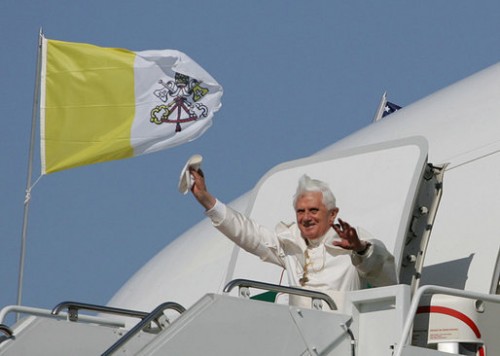Headlining Pope Benedict's Connections
 I'm guessing most reporters hate writing headlines. Your stories are often so nuanced or complex that no one can possibly condense it down to a few words. We've been reading several stories related to Pope Benedict XVI's connections to Peter Hullermann, a priest who had been convicted in 1986 of sexually abusing minors, and we've been taking special notice of whether the headlines and the story make the appropriate ties.
I'm guessing most reporters hate writing headlines. Your stories are often so nuanced or complex that no one can possibly condense it down to a few words. We've been reading several stories related to Pope Benedict XVI's connections to Peter Hullermann, a priest who had been convicted in 1986 of sexually abusing minors, and we've been taking special notice of whether the headlines and the story make the appropriate ties.
So far, it seems, The New York Times has done the best mainstream reporting, helping the reader explain the details without going overboard. We'll start by looking at this story, explaining how Pope Benedict XVI is and is not connected to the case. When he was Cardinal Ratzinger and Archdiocese of Munich and Freising in 1980, he approved the entry of a priest from a separate diocese to undergo counseling in Munich; a subordinate later approved the priest for a parish assignment.
The Times reported yesterday that the priest was suspended on Monday, even though he was convicted of molesting boys in previous years.
The priest, Peter Hullermann, who had previously been identified only by the first letter of his last name, was suspended from his duties only on Monday. That was three days after the church acknowledged that the pope, then Archbishop Joseph Ratzinger, had responded to early accusations of molestation by allowing the priest to move to Munich for therapy in 1980.
The story probably should have clarified again that Ratzinger did not approve the priest for a parish assignment. Here's what CatholicCulture.org has to say.
As officials both in Munich and at the Vatican had previously explained, the vicar-general of the Munich archdiocese later allowed Father Hullerman to work in a parish. The vicar general has stated that he made this decision without the knowledge-- let alone approval-- of Cardinal Ratzinger.
Father Hullerman was given a parish assignment in September 1982-- 7 months after Cardinal Ratzinger resigned his post as Archbishop of Munich, having taken up his new responsibilities as prefect of the Congregation for the Doctrine of the Faith.
Next we have a Times (U.K.) headline, which flatly states, "Pope knew priest was paedophile but allowed him to continue with ministry." Take a look at this paragraph from the story.
Mgr Gruber said that the Pope, who was made a cardinal in 1977, had not been not aware of his decision because there were 1,000 priests in the diocese at the time and he had left many decisions to lower-level officials.
The headline then appears to contradict the assertion made in the article. Damian Thompson of the Telegraph says there's Catholic fury over the Times's coverage, while Ruth Gledhill of the Times calls the Telegraph's coverage "a disgrace." Rivalry much?
Anyway, Gledhill offers some historical perspective that might assist more journalists as they cover the story.
What is often forgotten is how little was known of paedophilia. It was believed it could be cured, and that penitence was tantamount to recovery.
The Church, in its ignorance of the recidivism of paedophiles, too often gave them a second, third or fourth chance, moving them to different parishes, or even different countries, where they just abused again. Children's homes made the same mistake.
Adding a sentence or two that explains the assumptions made in the 1980s doesn't change what happened and shouldn't change the coverage. It might, however, give readers a better understanding of why decisions were made.
Gledhill also highlights some Italian coverage. Check out some of these headlines:
Sole 24 Ore (Milan financial paper): Germany attacks its Pope. He is accused of having accepted a paedophile priest when he was Archbishop of Munich in Bavaria.
Il Messaggero, Rome daily: Paedophila, abuses at Munich when Ratzinger was bishop. Father Lombardi: he is not involved.
AGI, Italian news agency: Paedophilia: in Munich, Ratzinger accepted a priest for a cure
Reuters Italia: A paedophile priest in the Pope's ex diocese.
La Stampa: Paedophilia, new disaster for the Vatican: case emerges of a priest at Munich when Ratzinger was bishop.
I prefer The New York Times's headline, "Abuse Scandal in Germany Edges Closer to Pope." It makes the connection without misleading the reader. Have you thanked a copy editor today? He or she could make or break your next story.
Reuters's Tom Heneghan takes L'Avvenire, the Italian Bishops Conference newspaper, to task for burying the lead.
In the middle of the front page (at left), it ran the headline "Il 'pm' vaticano: in tutto il mondo trecento i preti accusati di pedofilia." -- Vatican public prosecutor: 300 priests accused of pedophilia in the whole world." That actually doesn't sound like that many, given all the cases we've heard about all these years.
It's only in the interview on page 5 that the real picture emerges. There the reader finds a much larger figure of 3,000 accusations of sexual misdeeds of all kinds made against priests since 2001, concerning cases dating back up to 50 years ago.
Reporters working on this story should consider reading John Allen's lengthy analysis that was just posted today on how the story could impact Benedict XVI. It's important to break news, and it's also sometimes appropriate to take a few days to look at the big picture. This story isn't going away. Let us know if you see particularly good or bad headlines or stories.